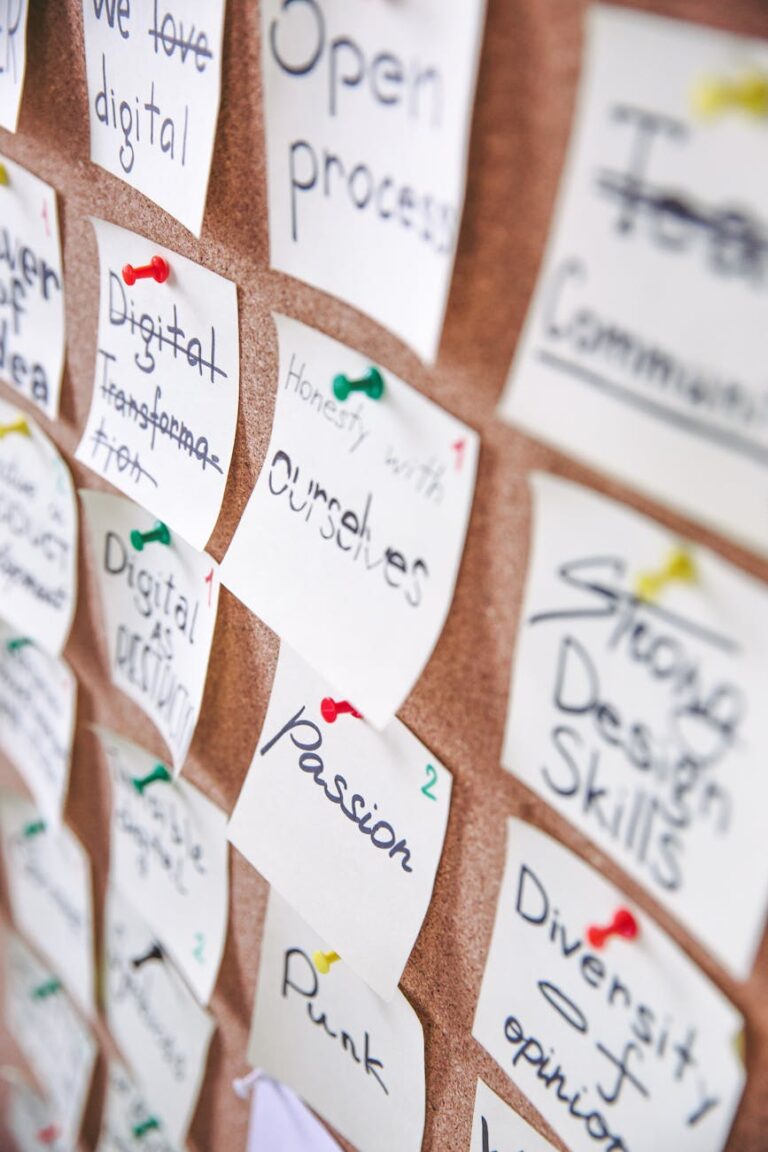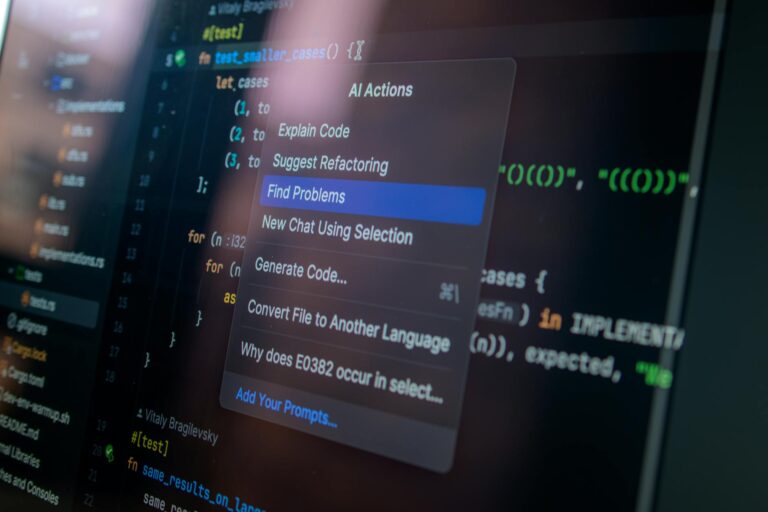Key 2025 Tech Trends Shaping Business Success
Navigating the Future: Essential 2025 Tech Trends Shaping Business Success
Estimated reading time: 10 minutes
Key Takeaways
- Embrace performance-first web development with frameworks like Next.js and optimize React for speed and SEO.
- Prioritize cross-platform mobile development (Flutter/React Native) and user-centric UI/UX design for wider reach.
- Leverage cloud computing (serverless, cloud migration) and DevOps (CI/CD) for scalability, efficiency, and cost reduction.
- Implement AI automation for businesses, focusing on repetitive task automation, smart chatbots, and low-effort AI features for user delight.
- Integrate modern UI/UX design principles, emphasizing accessibility, responsiveness, and intuitive interfaces, to create engaging and efficient digital experiences.
Table of Contents
- Embracing 2025 Web Development Trends for Unprecedented Growth
- Mobile App Development 2025: Reaching Your Audience Anywhere, Anytime
- Mastering Cloud Computing and DevOps for Scalability and Efficiency
- AI Automation for Businesses: Unleashing Productivity and Innovation
- Elevating User Experience with Modern UI/UX Design
- Connecting the Dots: Your Digital Transformation Journey
- Partnering for Progress: How AITechScope Empowers Your Business
- Ready to navigate the exciting 2025 tech trends?
- FAQ: Frequently Asked Questions
Embracing 2025 Web Development Trends for Unprecedented Growth
The digital landscape is a relentless torrent of innovation, constantly reshaping how businesses operate, communicate, and grow. For forward-thinking professionals, entrepreneurs, and tech leaders, understanding the currents of these changes isn’t just an advantage—it’s a necessity. As we look towards 2025, a confluence of powerful 2025 tech trends in web development, mobile applications, cloud infrastructure, AI automation, and user experience design is converging to redefine efficiency, scalability, and market reach.
At AITechScope, we believe that staying ahead means not just observing these trends but strategically integrating them into your business operations. This comprehensive guide will break down the most impactful technological shifts, offering practical insights and demonstrating how intelligent adoption can accelerate growth, improve performance, and fundamentally transform your company.
The web remains the cornerstone of digital presence, but its capabilities are evolving at an astonishing pace. The focus for 2025 is clear: speed, personalization, and intelligence. Businesses can no longer afford sluggish, static websites; the expectation is for dynamic, highly performant, and user-centric experiences.
The Rise of Performance-First Frameworks: Next.js and React
For small businesses and startups aiming to make a significant impact online, frameworks like Next.js are becoming indispensable. Next.js, built on React, offers a powerful combination of server-side rendering (SSR), static site generation (SSG), and incremental static regeneration (ISR). What does this mean in plain English? It allows businesses to build lightning-fast marketing sites, e-commerce platforms, and content hubs that load almost instantly, enhancing user experience and significantly boosting SEO. Our research shows that a fast marketing site built with Next.js can be deployed in as little as one weekend, making it an ideal solution for agile teams and lean budgets.
Beyond Next.js, optimizing React performance is crucial for any web application. Simple fixes, such as memoization, lazy loading components, and optimizing image delivery, can reduce page load times by seconds. We’ve seen real-world case studies where page load times were cut by 60% for clients through targeted performance optimizations, directly translating to higher engagement and lower bounce rates. This focus on performance isn’t just about speed; it’s about providing a frictionless user journey that keeps visitors engaged.
AI-Powered Web Applications: The Smart Web
The web of 2025 isn’t just fast; it’s smart. Integrating low-effort AI features into web applications can profoundly delight users and streamline operations. Imagine a SaaS product that offers personalized recommendations based on user behavior, an e-commerce site with intelligent product search, or a customer portal with proactive support. These aren’t futuristic concepts; they are accessible today. Simple AI integrations, like smart chatbots for instant support or AI-driven content suggestions, can significantly enhance user satisfaction and drive conversions. For businesses, this means creating more intuitive, responsive, and ultimately more effective online platforms.
Beyond Traditional CMS: Headless WordPress and Micro Frontends
Content management is also undergoing a revolution. While WordPress remains dominant, its evolution towards a “headless” architecture offers unparalleled flexibility. A headless CMS WordPress setup separates the content backend from the frontend presentation layer. This allows businesses to use WordPress for content creation while leveraging modern frameworks like Next.js or React for a blazing-fast, customized frontend. The result is a highly performant, secure, and scalable website that combines the ease of WordPress content management with cutting-edge web development.
For larger enterprises or complex applications, micro frontends are gaining traction. This architectural approach breaks down a monolithic frontend into smaller, independently deployable units. While they offer benefits in terms of team autonomy and scalable development, it’s crucial to understand when they help and when they can introduce unnecessary complexity. For most small to medium businesses, a performant monolithic or a headless CMS approach will offer the best balance of flexibility and efficiency.
Practical Takeaways for Web Development:
- Prioritize Performance: Leverage frameworks like Next.js and optimize React applications for lightning-fast load times.
- Integrate Smart Features: Explore low-effort AI integrations for personalization, intelligent search, or enhanced user support.
- Embrace Flexibility: Consider a headless CMS approach for greater control over your frontend experience.
AITechScope specializes in building high-performance, AI-powered websites using modern frameworks. Our expertise in Next.js allows us to create fast, SEO-friendly marketing sites and complex web applications tailored to your business needs, ensuring you’re not just present online, but truly performant.
Mobile App Development 2025: Reaching Your Audience Anywhere, Anytime
If your business isn’t considering a robust mobile strategy, it’s falling behind. Research consistently shows that mobile applications are the primary point of digital interaction for countless users, with downloads constantly placing them “in the first place.” In 2025, the mobile landscape demands even greater sophistication, speed, and cross-platform accessibility.
Cross-Platform Dominance: Flutter vs. React Native
The debate between Flutter vs. React Native in 2025 continues, but the overarching trend is clear: cross-platform development is king. Both frameworks allow developers to build native-like applications for iOS and Android from a single codebase, drastically reducing development time and cost.
- Flutter, backed by Google, offers exceptional performance and a highly expressive UI toolkit, making it ideal for creating beautiful, custom designs. Building a simple cross-platform app with Flutter, from idea to Play Store, is more accessible than ever.
- React Native, supported by Facebook, leverages JavaScript, making it a natural choice for teams already familiar with web development using React.
Choosing between them depends on your specific business needs, team expertise, and desired UI complexity. The critical takeaway is the power of cross-platform development to accelerate your market entry and ensure a consistent user experience across devices.
User Experience at the Forefront: Mobile App UI Trends
Beyond the underlying technology, the success of a mobile app hinges on its user experience. Mobile app UI trends for 2025 emphasize intuitive, accessible, and engaging interfaces. This means:
- Simplified Navigation: Clean layouts and minimal steps to achieve tasks.
- Personalization: Tailoring content and features to individual user preferences.
- Accessibility: Ensuring the app is usable by everyone, regardless of ability.
- Micro-interactions: Small, delightful animations that provide feedback and enhance engagement.
The goal is to create an app that not only performs its function but also feels natural, enjoyable, and indispensable to the user.
Practical Takeaways for Mobile App Development:
- Prioritize Mobile: Develop a strategic approach for mobile presence, whether a dedicated app or an optimized web experience.
- Embrace Cross-Platform: Utilize frameworks like Flutter or React Native for efficient development and wider reach.
- Focus on UX: Invest in intuitive, accessible, and engaging UI design to retain users.
AITechScope provides strategic consulting for mobile app development, guiding businesses through framework selection, UI/UX design, and development best practices to ensure your app connects effectively with your target audience.
Mastering Cloud Computing and DevOps for Scalability and Efficiency
The agility and resilience of modern businesses are directly tied to their infrastructure. In 2025, cloud computing and DevOps aren’t just buzzwords; they are fundamental operational pillars. They enable businesses to scale rapidly, deploy faster, and reduce operational overhead.
Serverless Architecture: The Epitome of Efficiency
For startups and small businesses, serverless architecture on AWS offers a revolutionary way to build cost-efficient, automatically scaling backends. With serverless, you only pay for the compute resources consumed during code execution, eliminating the need to provision or manage servers. This dramatically reduces infrastructure costs and operational burden, allowing teams to focus on core product development. It’s the ultimate example of “pay-as-you-go” scalability, perfect for fluctuating workloads and unpredictable growth.
Seamless Transitions: Cloud Migration Strategy
For businesses with existing legacy applications, migrating to the cloud can seem daunting. However, a well-defined cloud migration strategy is crucial for long-term sustainability and innovation. The key is to approach migration without breaking existing operations. This often involves a phased approach, identifying dependencies, modernizing components where possible, and utilizing cloud-native services gradually. The benefits—enhanced security, improved performance, and reduced TCO—far outweigh the initial challenges.
CI/CD for Small Teams: Automated Deployments Without the Headache
DevOps isn’t just for tech giants. For small teams, implementing CI/CD automation (Continuous Integration/Continuous Deployment) is a game-changer. Tools like GitHub Actions allow small teams to automate their entire deployment pipeline, from code commit to production. This eliminates manual errors, speeds up development cycles, and ensures consistent, reliable deployments without the overhead of complex, enterprise-level setups. It’s about achieving “automated deployments without the headache,” freeing up valuable developer time.
Microservices Architecture: Building Resilient Systems
While complex, microservices architecture continues to gain traction for its ability to create highly scalable, resilient, and independently deployable services. By breaking down applications into smaller, loosely coupled components, businesses can update, scale, and manage specific parts of their system without affecting the entire application. This is particularly beneficial for complex SaaS products requiring high availability and continuous innovation.
Practical Takeaways for Cloud & DevOps:
- Embrace Serverless: Leverage serverless architecture for cost-efficient, scalable backend solutions.
- Plan Cloud Migration: Strategically move legacy applications to the cloud to unlock modern benefits.
- Automate Deployments: Implement CI/CD for faster, more reliable software releases, even with small teams.
AITechScope offers expert DevOps consulting and cloud migration strategies, helping businesses design and implement scalable, cost-efficient infrastructure. We can guide you through serverless adoption and set up automated CI/CD pipelines to streamline your development and deployment processes.
AI Automation for Businesses: Unleashing Productivity and Innovation
Artificial intelligence is no longer a futuristic concept; it’s a practical, accessible tool transforming daily business operations. In 2025, AI automation for businesses will be the primary driver of efficiency, enabling companies to do more with less, free up human talent, and focus on strategic growth.
Automate Repetitive Tasks with No-Code Tools + AI
One of the most immediate and impactful applications of AI is automating repetitive, time-consuming tasks. Research shows that businesses can save 5–10 hours/week by leveraging no-code tools combined with AI. This can range from automating data entry and report generation to scheduling emails and managing customer queries. Tools like n8n, a powerful workflow automation platform, can integrate AI services to create intelligent workflows that learn and adapt. This capability directly relates to AITechScope’s specialization in n8n workflow development and AI-powered virtual assistant services.
Chatbot Automation for Small Businesses: Real Workflows That Work
For small businesses looking to enhance customer service and lead generation without expanding their team, chatbot automation for customer service is a game-changer. AI chatbots can handle frequently asked questions, qualify leads, book appointments, and provide 24/7 support. This frees up human agents to focus on complex issues, significantly improving customer satisfaction and operational efficiency. We’ve seen real workflows where small businesses use chatbots to save time, providing instant responses and filtering inquiries effectively.
Low-Effort AI Features That Delight Users
As mentioned earlier, AI isn’t just about internal efficiency; it’s about enhancing user experience. For SaaS products, integrating low-effort AI features that delight users can be a competitive differentiator. Examples include:
- Smart Search: AI-powered search that understands intent, not just keywords.
- Personalized Recommendations: Tailoring content or product suggestions based on user behavior.
- Intelligent Summarization: Automatically summarizing long documents or threads.
These features, often implemented with readily available AI APIs, require minimal development effort but deliver significant value to users.
Digital Transformation on a Budget: AI as an Enabler
For small companies, digital transformation on a budget might seem like a distant dream. However, AI automation provides an accessible entry point. By strategically automating key business processes, even small companies can achieve significant gains in efficiency and competitiveness. It’s about taking “7 steps small companies can start today” towards a more digital future, with AI as a central enabling technology.
Practical Takeaways for AI Automation:
- Identify Automation Opportunities: Pinpoint repetitive tasks across departments that can be automated.
- Start with Chatbots: Implement AI chatbots for immediate improvements in customer service and lead qualification.
- Leverage No-Code AI: Explore platforms like n8n to build intelligent workflows without extensive coding.
AITechScope’s core expertise lies in AI automation for businesses. We specialize in developing custom n8n workflows that integrate AI, providing intelligent virtual assistant services, and offering AI consulting to help you identify and implement the most impactful automation solutions, reducing costs, and scaling operations through intelligent delegation.
Elevating User Experience with Modern UI/UX Design
In a crowded digital marketplace, a product’s success often hinges on its design. Modern UI/UX design is about creating not just visually appealing interfaces, but profoundly intuitive, efficient, and accessible experiences.
The Power of Accessible Design
Accessibility is no longer an afterthought; it’s a foundational principle. Designing accessible interfaces ensures your products are usable by everyone, including those with disabilities, broadening your audience and enhancing your brand’s reputation. Simple guidelines, like those for designing accessible buttons, can make a huge difference. These aren’t just technical requirements; they are ethical imperatives that lead to better design for all users.
Responsive UI Design: Seamless Experiences Across Devices
With the proliferation of devices, responsive UI design is non-negotiable. Your website or app must adapt seamlessly to various screen sizes and orientations, from large monitors to small mobile screens. A consistent and optimized experience across all touchpoints reduces friction, improves user satisfaction, and reinforces brand identity.
Intuitive Interfaces: Reducing Cognitive Load
The best designs are those that are invisible. Users shouldn’t have to think about how to use your product; it should feel natural. Mobile app UI trends emphasize clarity, simplicity, and directness. This means thoughtful information architecture, clear calls to action, and reducing cognitive load wherever possible. Every interaction should guide the user effortlessly towards their goal.
Practical Takeaways for UI/UX Design:
- Prioritize Accessibility: Design with inclusivity in mind from the outset.
- Ensure Responsiveness: Provide a consistent and optimized experience across all devices.
- Focus on Intuition: Strive for designs that are easy to understand and use, minimizing user effort.
AITechScope understands that powerful technology must be paired with exceptional design. Our website development services integrate modern UI/UX principles to ensure your digital platforms are not only functional but also highly engaging and user-friendly.
Connecting the Dots: Your Digital Transformation Journey
These 2025 tech trends are not isolated silos; they are interconnected forces driving a holistic digital transformation strategy. A high-performance website (Next.js, React) integrated with intelligent AI features, supported by a scalable cloud infrastructure (serverless, DevOps), and accessed through intuitive mobile applications (Flutter/React Native) – all underpin a seamless and efficient business ecosystem. Even for small businesses, this synergy translates into increased efficiency, reduced operational costs, improved customer satisfaction, and a significant competitive edge.
The journey of digital innovation for startups and established companies alike involves carefully selecting the right technologies and integrating them effectively. It’s about leveraging performance optimization techniques, adopting modern tech stacks, and ensuring that every technological investment contributes directly to business goals like workflow optimization and SaaS product optimization.
Partnering for Progress: How AITechScope Empowers Your Business
Navigating the complex landscape of 2025 tech trends requires expertise and a strategic partner. AITechScope is a leading provider of virtual assistant services, specializing in helping businesses leverage cutting-edge AI tools and technologies. We bridge the gap between innovation and practical application.
Our services are designed to specifically address the challenges and opportunities presented by these trends:
- AI Automation Services: We identify repetitive tasks and implement intelligent automation solutions, utilizing platforms like n8n, to dramatically improve workflow efficiency and reduce operational costs.
- AI Consulting: We provide strategic guidance on how to best integrate AI into your products and processes, ensuring you make smart, impactful investments.
- n8n Workflow Development: We build robust, custom automation workflows that connect your disparate systems and automate complex business processes.
- Website Development: We create high-performance, AI-powered websites using modern frameworks like Next.js, ensuring your online presence is fast, secure, and engaging.
- Virtual Assistant Services: Our AI-powered virtual assistants provide intelligent delegation, allowing your team to focus on high-value tasks while routine operations are handled seamlessly.
By partnering with AITechScope, you’re not just adopting new technologies; you’re building a more efficient, scalable, and future-proof business. We empower you to harness the power of AI automation, optimize your digital infrastructure, and transform your operations for sustained growth.
Ready to navigate the exciting 2025 tech trends and transform your business?
Don’t let the rapid pace of technological change overwhelm you. Let AITechScope be your guide. Explore our AI automation, n8n workflow development, and consulting services to discover how intelligent delegation and cutting-edge technology can propel your business forward.
Contact us today for a consultation and start your journey towards a more automated, efficient, and successful future.
FAQ: Frequently Asked Questions
- What are the most impactful 2025 tech trends for businesses?
- How can Next.js benefit my small business website?
- Should my business choose Flutter or React Native for mobile app development?
- What is serverless architecture and how does it help reduce costs?
- How can AI automation save my business time and money?
What are the most impactful 2025 tech trends for businesses?
The most impactful 2025 tech trends include performance-first web development (Next.js, React), cross-platform mobile development (Flutter, React Native), scalable cloud infrastructure (serverless, DevOps), AI automation for efficiency, and modern UI/UX design focusing on accessibility and intuition.
How can Next.js benefit my small business website?
Next.js enables small businesses to build lightning-fast, SEO-friendly websites through server-side rendering and static site generation. This significantly enhances user experience, improves search engine rankings, and can be deployed rapidly, making it cost-effective for agile teams.
Should my business choose Flutter or React Native for mobile app development?
Both Flutter and React Native are excellent cross-platform frameworks. Flutter offers exceptional performance and a highly expressive UI, ideal for custom designs. React Native, using JavaScript, is great for teams already familiar with web development. The choice depends on your specific business needs, team expertise, and desired UI complexity.
What is serverless architecture and how does it help reduce costs?
Serverless architecture allows you to build and run applications without managing servers. You only pay for the compute resources consumed during code execution. This dramatically reduces infrastructure costs and operational burden, as you don’t need to provision or maintain servers, making it highly efficient for fluctuating workloads.
How can AI automation save my business time and money?
AI automation saves time and money by automating repetitive tasks like data entry, report generation, and customer inquiries. This frees up human talent for strategic work, reduces operational costs, and improves efficiency. Tools like AI-powered chatbots can also enhance customer service and lead generation 24/7.







